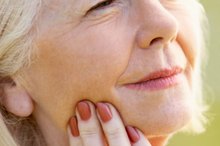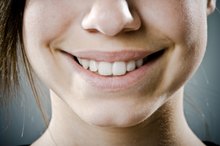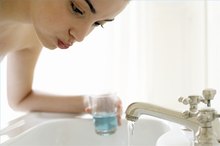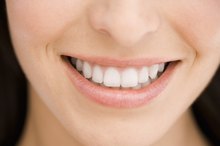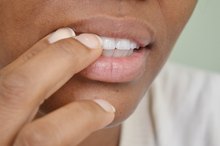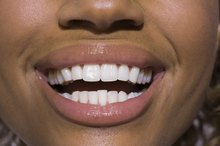How to Get Rid of a Tooth Ache Fast
A toothache is usually caused by dental decay, sometimes called dental caries or dental cavities. You may experience a sharp or throbbing pain after eating something cold or if you are also suffering from a sinus infection. An ear infection or a heart attack can cause referred pain to your tooth. You should contact your dentist if you experience a toothache caused by dental decay. In the meantime, you can relieve your tooth pain quickly at home with home remedies and over-the-counter medications.
Swish your mouth with warm water, recommends MayoClinic.com. If your toothache started or got worse after you took a bite of ice cream or a sip of icy water, the warm water may calm the nerve temporarily. Swishing vigorously can also remove any particles of food that are stuck in a cavity, causing pain.
Tooth Pain After Eating
Learn More
Remove anything stuck between your teeth. Use dental floss or a water pik to clean out around the gums. A sliver of popcorn or a small string from corn on the cob can cause a toothache if you allow it to remain stuck in your teeth.
Take an over-the-counter pain medication to control the pain, suggests Medline Plus 3. Try acetaminophen or ibuprofen if you do not have health issues that prevent you from taking them. Follow the directions on the bottle carefully and avoid overdosage.
How to Remove Tooth Tartar at Home
Learn More
Place a whole clove between your aching tooth and your cheek. The Doctor's Book of Home Remedies states that cloves and clove oil can temporarily relieve a toothache. Once the clove softens up, chew on it gently for up to a half hour.
Apply ice to the side of your face. The Doctor's Book of Home Remedies suggests wrapping an ice pack in a towel and holding it to your face for 15 minutes per hour. If you are experiencing swelling with your toothache, the ice will reduce it, along with reducing the nerve inflammation.
Tips
If you have sinus congestion or ear pain on the same side as your toothache, see your doctor; you may have a sinus or ear infection that is radiating pain into your tooth.
Warnings
If you are experiencing chest, jaw or neck pain along with your toothache, or if you have other symptoms of a heart attack, call 911 or seek emergency medical care.
Related Articles
References
- Mayoclinic.com: Toothache First Aid
- New York Times Health Guide: Toothaches
- Medline Plus: Toothaches
- Sanders JL, Houck RC. Dental Abscess. [Updated 2019 Jun 30]. In: StatPearls [Internet]. Treasure Island (FL): StatPearls Publishing; 2020 Jan-. Available from: https://www.ncbi.nlm.nih.gov/books/NBK493149/
- Sanders JL, Houck RC. Dental Abscess. [Updated 2019 Jun 30]. In: StatPearls [Internet]. Treasure Island (FL): StatPearls Publishing; 2020 Jan-.
- Baatsch B, Zimmer S, Rodrigues recchia D, Büssing A. Complementary and alternative therapies in dentistry and characteristics of dentists who recommend them. Complement Ther Med. 2017;35:64-69.
- Alqareer A, Alyahya A, Andersson L. The effect of clove and benzocaine versus placebo as topical anesthetics. J Dent. 2006;34(10):747-50.
- Marya CM, Satija G, J A, Nagpal R, Kapoor R, Ahmad A. In vitro inhibitory effect of clove essential oil and its two active principles on tooth decalcification by apple juice. Int J Dent. 2012;2012:759618. doi:10.1155/2012/759618
- Kamkar Asl M, Nazariborun A, Hosseini M. Analgesic effect of the aqueous and ethanolic extracts of clove. Avicenna J Phytomed. 2013;3(2):186–192.
- Sisson D, Balmer C. A chemical burn from a garlic poultice applied to the face to treat toothache: a case report. Prim Dent J. 2014;3(1):28-9.
- Bagga S, Thomas BS, Bhat M. Garlic burn as self-inflicted mucosal injury--a case report and review of the literature. Quintessence Int. 2008;39(6):491–494.
- Rostami AM, Brooks JK. Intraoral chemical burn from use of 3% hydrogen peroxide. Gen Dent. 2011;59(6):504–506.
- Alqareer A, Alyahya A, Andersson L. The effect of clove and benzocaine versus placebo as topical anesthetics. J Dent. 2006 Nov;34(10):747-50.
- Baatsch B, Zimmer S, Recchia DR, Büssing A. Complementary and alternative therapies in dentistry and characteristics of dentists who recommend them. Complementary Therapies in Medicine. 2017;35:64-69.
- Sisson D, Balmer C. A Chemical Burn from a Garlic Poultice Applied to the Face to Treat Toothache: A Case Report. Primary Dental Journal. 2014;3(1):28-29.
Writer Bio
Michelle Kulas worked in the health-care field for 10 years, serving as a certified nurses' assistant, dental assistant and dental insurance billing coordinator. Her areas of expertise include health and dental topics, parenting, nutrition, homeschooling and travel.
